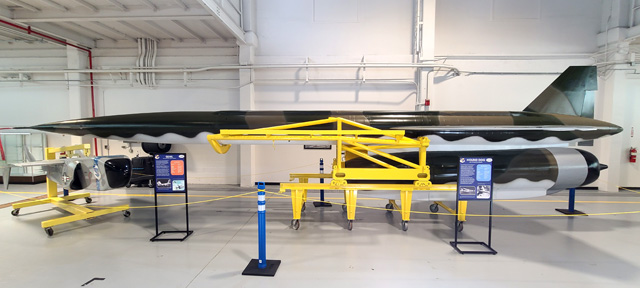
Photo Gallery
Overview
Display location:
- Hangar C, Cape Canaveral Space Force Station
Type: Air-to-ground guided missile
Designation: GAM-77 / AGM-28
Serial Number: 33792
Payload: Nuclear warhead
Agency: U.S. Air Force
Contractor: North American Aviation
Launch Complex: B-52 on Eastern Test Range
Cape Canaveral Air Force Station Operations: 1959-1965
History
Design of the Hound Dog missile began in 1957, adapted from the Navaho X-10 cruise missile prototype. Hound Dog was a supersonic, air-launched missile, which carried a nuclear weapons payload. It was the first nuclear missile to be carried aboard U.S. Air Force Strategic Command (SAC) aircraft. The Hound Dog served to fill a cruise missile gap, which existed following the cancellation of the Navaho program.
Initially designated AGM-77, the Hound Dog featured small canard foreplanes, rear delta wings with ailerons, plus a small fin and rudder. The vehicle was powered by a Pratt and Whitney turbojet, which could produce a thrust of 7,500 pounds. The engine was located in an underslung rear pod. It featured variable inlet and nozzle systems, which could adjust the speed and altitude of the missile. This permitted the Hound Dog to cruise at altitudes ranging from treetop level to 55,000 feet. The Hound Dog was guided by a North American Autonetics Division inertial guidance system that was later upgraded to incorporate a Kollsman Star Tracker.
Display Locations
The original Hound Dog mockup on display in the Museum Rocket Garden was later moved to the median of Phillips Parkway on Cape Canaveral Space Force Station and used as a signpost directing visitors to the museum. That Hound Dog was removed many years later due to extensive weather damage and remains in storage.
The Hound Dog now on display arrived in late 1967 to replace the first Hound Dog and came complete with a ground maintenance fixture seen supporting the missile.
